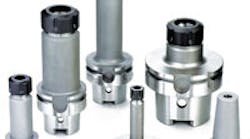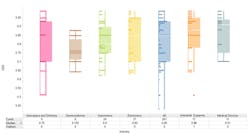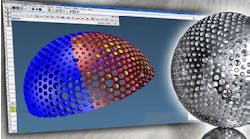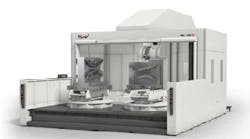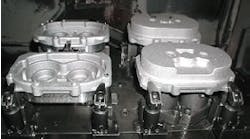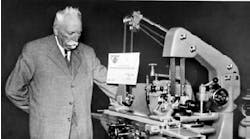Because most machinists do not understand the basics of toolholder balancing, they frequently spend more time and money than necessary trying to achieve a high level of balance.
Operational requirements should dictate the level of toolholder balancing necessary.
Operations that run at low speeds can tolerate a greater amount of toolholder unbalance than those that run at high speeds.
Optimal balancing for an application requires understanding:
The effects of unbalance and when they are important.
When to apply the best control strategy.
And, how different toolholder configurations perform as speeds increase.
“Toolholders are balanced by measuring them after production is complete, and making necessary mass corrections,” said Dennis King, director of engineering at Command Tooling Systems (www.commandtool.com) “Balanceable holders should be hard-balanced (material removed) to bring them into good balance performance. Then, balanceable features should be used to correct variables from the presetting process, if they are of significance to the operation.” There are two standards that are specific to toolholder or spindle balance: ISO 1940 and ANSI S2.19. Each was created by a committee that broke balance control into three categories:
Vibration control.
Force control.
Part-production ability.
Of these three methods, vibration control is used most often.
HSK E and F toolholders are symmetrical and, therefore, balanced off the drawing board.
Balancing strategies
Manufacturers often specify the level of unbalance by a G number with units in millimeters per second (mm/sec).
Other ways to describe vibration in a part spinning at some rotational speed include acceleration, velocity and peak-to-peak displacement.
The ANSI S2.19 standard goes into considerable detail regarding singleplane and two-plane balance, and how to calculate acceptable unbalances when using the vibration method, commonly known as the Gnumber specification.
G numbers are vibration threshold limits. The number G1.0 corresponds to a free spinning vibration of 1.0 mm/sec.
Because high-tolerance grinding operations involve a stable workpiece and spindle, the number G 1.0 usually is specified for grinding spindles.
Grinding typically involves a constant force (except in the case of interruptions) from the thousands of workpiece interactions producing an averaging effect that makes operational forces very uniform.
A machining operation usually has higher loads than grinding operations, and each machining operation has its own frequency and amplitude. Tooth impacts create vibrations that are larger than those generated during grinding, and these vibrations limit the effectiveness of very restrictive balancing.
“Variations in runout influence vibration and often eliminate the gains from balancing,” explained William Keefe, PE of Command Tooling Systems. “More vibration is allowed in machining than in grinding because machining tolerances generally are larger, and the overall operation will not benefit from stricter balance tolerance. For these reasons, machine-tool spindles and machine-tool parts usually are specified with vibration levels of G2.5 and G6.3.”
G numbers generally are assigned to an overall assembly.
A machine spindle assembly may have an overall design balance level of G6.3 in operation, while the spindle and the toolholders might be balanced to G2.5 Ievels.
Moreover, the weight and cylindrical configuration of a spindle allows it to be balanced easily to G2.5, G1.0 or even G0.4 levels.
The spindle’s main rotating mass can be balanced easily between or over centers, resulting in high resolution and repeatability. All major subcomponents of an assembly have the same vibrationlevel requirements.
Because the locating surface of a toolholder is a tapered cone, toolholder balancing is more difficult.
The toolholder’s light weight, coupled with the tapered cone/balancing machine, make balancing of toolholders difficult at G 1.0, G2.5 or G6.3 levels at high spindle speeds.
Ideally, surface finish is determined by feed rates, depth of cut and spindle speed. However, surface finish also is influenced by background vibration. Vibrations from a good cut should be multiples of the spindle speed (rpm). Forces that are generated at the spindle frequency, or a multiple thereof, include unbalance forces and the force of each tooth slicing away a chip of material.
Unbalance forces can act like additional runout in the assembly.
Command Tooling Systems estimates that the added runout, or dynamic runout, from•well-balanced tooling is 25 μin. to 50 μin. (0. 64 μm.to 1.3 μm.) On toolholders balanced to G12 at 15,000 rpm, this additional runout could be as high as 0.00016 in. (4.1 μm). On a given set of cutting tests at a major manufacturer, there was no discernable difference in surface finish with toolholders balanced to between G2.5 and G12.
However, this was one test and these results can be misleading if generalized. When chip loads are small, the effect of increased G-levels may be noticeable.
The vibration-level method is the most restrictive way of looking at balance.
Often, an unnecessarily restrictive balance level is specified because of a lack of understanding, or a desire to compensate for balancing that is not done or is done incorrectly.
Force control, another way of dealing with balance, requires an understanding of machining forces and balance forces, and managing the overall level to prevent spindle damage. Balance becomes more critical as speeds go up because forces resulting from unbalance are a function of the square of the speed.
In many low-speed applications, a balancing operation of any kind is not necessary. At low spindle speeds, balance is not critical because the balance- induced force is low.
However, at high speeds, the vibrational method is not practical, because the force equation yields very low (sometimes impractically low) allowable residual unbalance.
While the vibration method in some cases may overstate the importance of balance, force control methods overlook the fact that although the unbalance force may not damage the machine tool, the parts produced may not be acceptable.
Although a particular unbalance may not generate a force high enough to damage a spindle, the unbalance-force vector can function like runout and spoil the part surface finish if the tool has more than one cutting edge. This is because the unbalance force rotates with the cutting tool, and that force always will be directed in the same orientation relative to the spindle face.
Even a slight unbalance can create an unbalance force of 100 lbf (445 N), if it is spun fast enough, and this force is sufficient to pull the spindle centerline around in a circle with a radius equal to the spring constant of the spindle times the force created by the unbalance. This spindle-centerline runout is caused by toolholder unbalance.
“The vibration method is conservative and guarantees that balance issues are addressed,” said King. “However, in some instances it is not economically or physically possible to adhere to this method. In these cases, the force created should be evaluated and, if low enough, a trial-and-error process can be initiated with the help of the machine tool manufacturer and a toolholder supplier to determine whether tight tolerances can be produced. When toolholders spin above 30,000 rpm, G2.5 is not attainable. Because of the mechanisms involved in gripping and locating a toolholder, any time spent trying to get below 1 g-mm of unbalance is wasteful.”
Some toolholder shanks and toolholder noses are better than others from a balance perspective. In this article, toolholders are considered strictly from a balance perspective.
Toolholder Balance Considerations
Accuracy and gripping strength is of the utmost importance when considering which toolholder/cutting-tool interface to use.
In many operations, there are many choices that will work. When this is the case, balance can be a deciding factor.
Although they are symmetrical, frictional interfaces like a Morse or Jacobs taper should not be operated at high speed, and will therefore not be considered. Weldon-type endmill holders can be balanced, but they usually perform poorly due to runout and have a structurally weak configuration 90° from the set screws.
These two problems limit an endmill holder’s performance even though it can be balanced quite well and, with a consistent cutting tool, they repeat balance very well.
ANSI-style or CT-style shanks have the largest uncorrected balance.
They have offset drive keys for timing of cutting tool edges, and the offset drive keys can contribute about 90 g-mm to a 4O-taper tool holder and about 400 g-mm to a 5O-taper.
In addition, these styles have an unpiloted retention knob that can contribute 5 g-mm to 25 g-mm in any orientation.
Other toolholder standards perform better, and piloting the retention knob allows for better balance repeatability.
The DIN69871 standard and the MAS 403 (BT) both are similar to the CT, but with a metric piloted thread for the knob. The best design for balance is BT flange toolholders that do not have offset drive keys and are totally symmetrical.
Forms E and F HSK toolholders, the high-speed versions, have no asymmetries in their design, so they are perfectly balanced off the drawing board.
However, because Form A HSK toolholders have an inherent unbalance that is difficult to correct in two planes, they are worse than ANSI-style toolholders from the standpoint of balance.
Shell-mill toolholders can be balanced after assembly, but an error is usually introduced by size tolerances allowed on the pilot. Also, some cutters are not symmetrical.
The quality of being symmetrical is not the same as being even-numbered. Three and five-tip assemblies can be symmetrical; however, just because a cutter has four teeth, it may not be in balance.
Most indexable cutters have a maximum rated speed and, even though the cutter may be balanced for a higher speed, it should not be run faster than the maximum specified by the cutter manufacturer.
Milling chucks often are used in high-speed, high-power machining. While they have excellent accuracy and gripping strength, they tend to have nonrepeatable balance.
While this is not always the case, usually a higher number of moving elements relates to balance inconsistency.
Hydraulic chucks can be very repeatable and accurate.
Dynamic seals, such as the piston, always produce minute leakage. Given enough actuations, this leakage substantially limits performance.
A hydraulic holder also has a thin flexible membrane that limits its effectiveness for high-speed milling. In a drilling application, (usually at slow speed), the hydraulic holder is always considered a good application.
Collet-chuck toolholders provide adequate gripping force for high-speed machining.
However, slippage in this interface can occur during high-power machining — especially at low speeds — because the forces usually are higher than those produced by high-speed machining.
DR collet chucks have a fine pitch with a 60-degree, V-form that resists loosening at elevated speeds.
As a rule of thumb, the smaller the nose diameter, the faster it will be able to run without limitations. Collet interfaces and collets are symmetrical, have very good balance, and work well together.
Nosepieces that extract the collet need to have a balanced or symmetrical extraction device.
Shrink-fit toolholders have no moving elements and are the best high-speed connection. Their onepiece design locates the tool perfectly, and is symmetrical. Centrifugal force generated at spindle speeds above 50,000 rpm is the only thing that will relax the toolholder’s grip during operation.
Although a BT40 shrink-fit toolholder may be perfectly symmetrical, and therefore design-balanced for high-speed work, only after manufacturing variability has been removed can it run at 15,000 rpm.
A word of caution: You must be able to measure unbalance to be assured the toolholder has been properly balanced. A shrink-fit holder or collet chuck usually only needs to be hard balanced once at the factory. Unless spindle speeds are above about 30,000 rpm, a balanced toolholder can adequately satisfy all balance issues.
